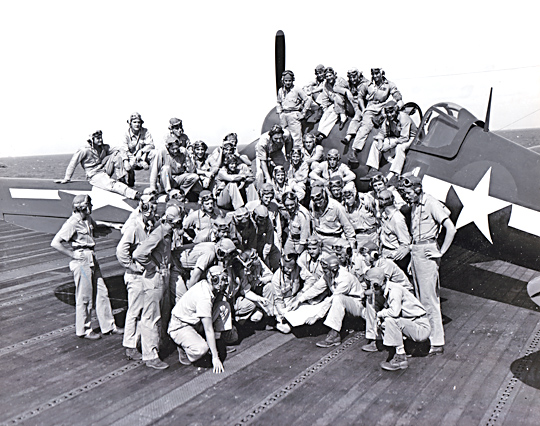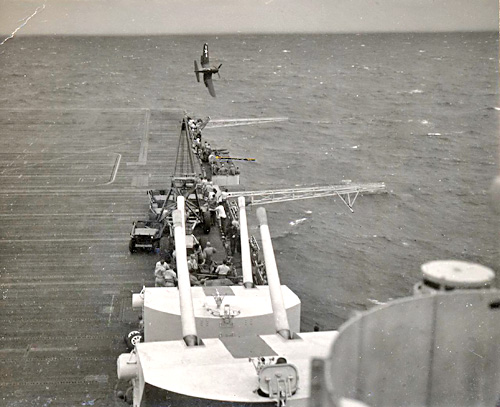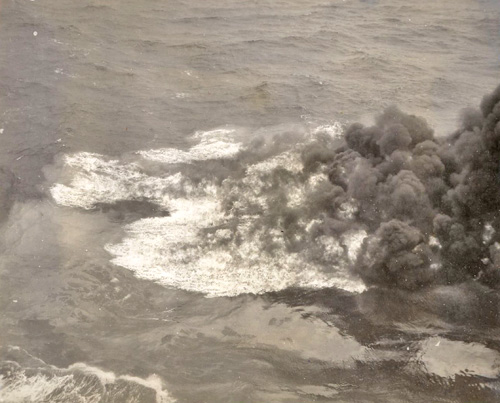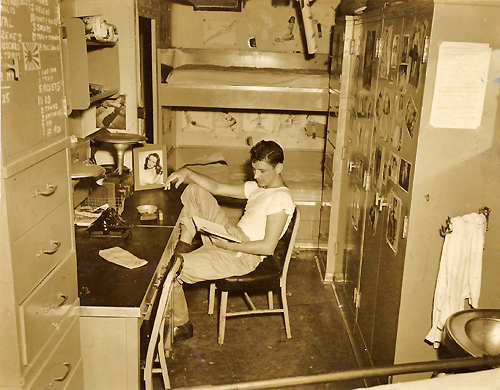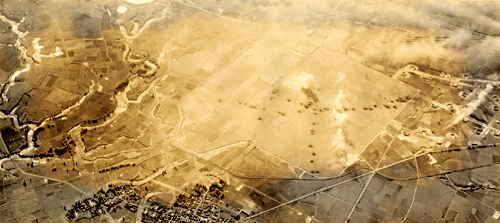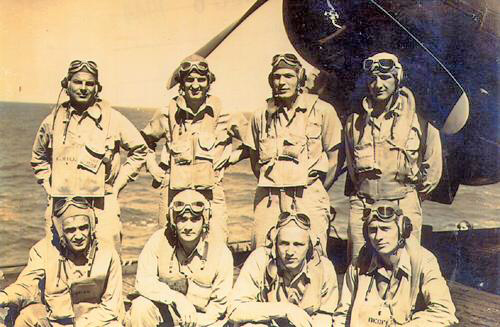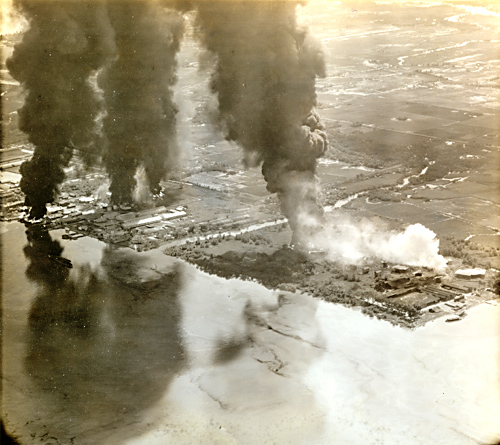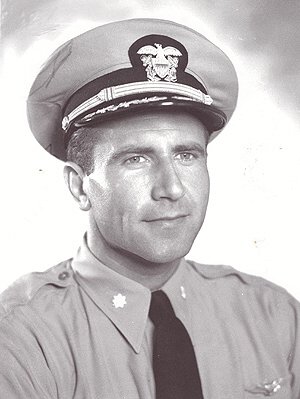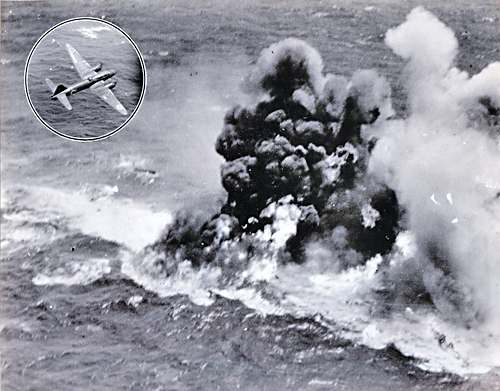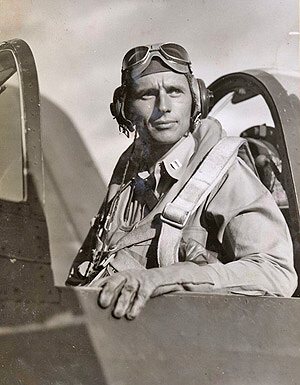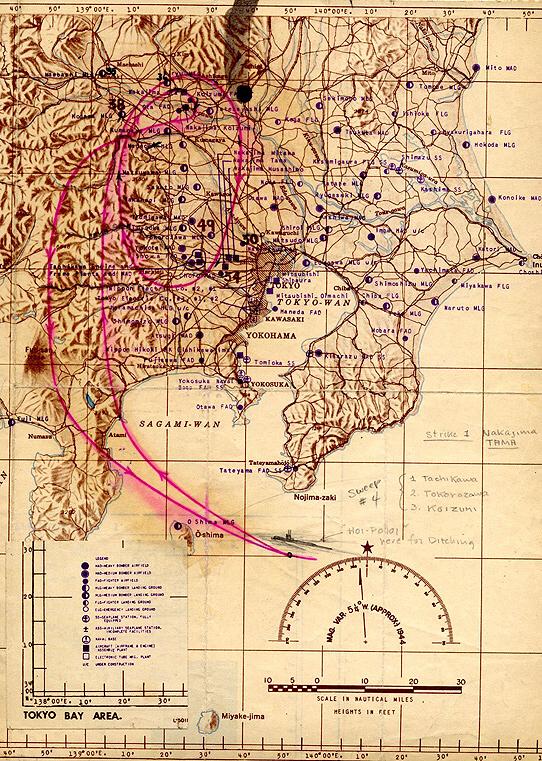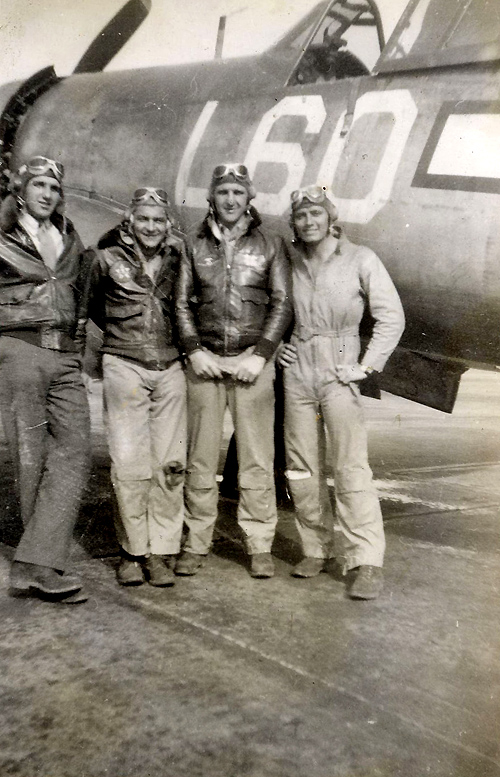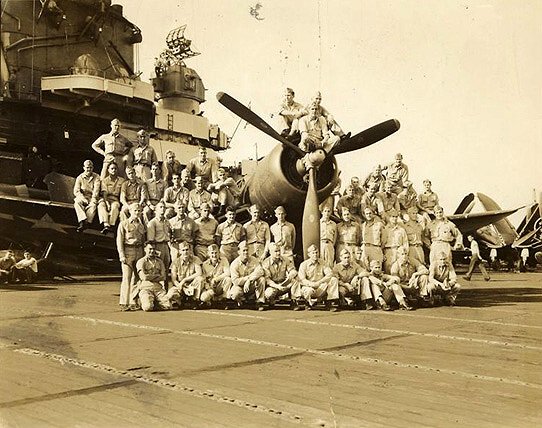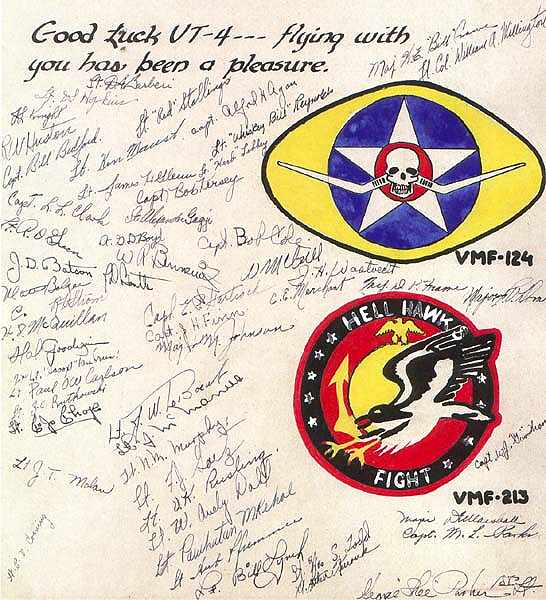|
|
||||||||||||||||||||||||
 |
||||||||||||||||||||||||
|
|
||||||||||||||||||||||||
|
||||||||||||||||||||||||
|
|
||||||||||||||||||||||||
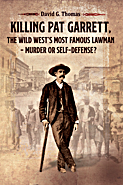 |
||||||||||||||||||||||||
 |
||||||||||||||||||||||||
 |
||||||||||||||||||||||||
|
|
||||||||||||||||||||||||
|
|
War Diary of Two Marine Squadrons -- VMF-124 |
|
By Gerald W. Thomas, VT-4 |
|
This brief history of the first carrier-based Marine Fighter Squadrons to serve in the Pacific is presented as a tribute to the pilots and support personnel of VMF-124 and VMF-213 and as a memorial to those who made the supreme sacrifice during World War II. In order to accurately report the activities of Squadrons VMF-124 and VMF-213, I have reviewed the declassified "War Diaries" and "Combat Reports" contained in the US Navy Operational Archives, Naval History Center, Washington, DC. All the material quoted directly from these sources is printed in italics. The other material is by the author. Most of the Combat Reports are signed by Lt. Col. William A. Millington (Commanding VMF-124) and/or Major David Ernest Marshall (Commanding VMF-213). VMF-124 and VMF-213 were ordered aboard the USS Essex on December 28, 1944 at Ulithi Lagoon. The Marines replaced our Dive-Bomber Squadron (VB-4). This change meant that the Essex now had a compliment of 55 F6F-5s, 36 F4U-1Ds, and 15 TBM-3Cs. The personnel component of the Marine Squadrons as they boarded the Essex was: |
|
|
|
"At the time of reporting to USS Essex, each pilot had had an average of 12 carrier landings (qualifications in San Diego and Hawaiian area aboard the USS Macassar Straits, USS Saratoga, and USS Bataan). Each pilot had an average total of about 400 hours flight time in the Corsair type fighter." There was considerable discussion among the Marines "as regards takeoffs and landings under various loading conditions." Carrier operations were very different from land-based activity. Our F6Fs were routinely carrying 1000-pound bombs and that presented a challenge to the Marine Corsairs. During a short "Shake Down:" "…despite the care exercised by the Air Department in allowing all safety margin possible, three accidents occurred in two days time, all undoubtedly due to the pilots lacking familiarity with the airplane in its higher loading condition (full ammunition and full belly tank). Two of the accidents were fatal, one spinning in on takeoff, the other on approaching for a landing. The third pilot was recovered. …all three planes hit the water on their backs. …after a week of operation, however, all pilots became more confident in handling the airplane" "The first loss was 2nd Lt. Thomas "Tom" Campion, Jr. who tried to smartly clear his takeoff slipstream by a hard right bank at slow speed. The Corsair was very unforgiving of that maneuver and promptly spun in, landing on its back. Tom could not be seen after the plane entered the water. The second was 2nd Lt. Barney W. Bennett. He took a wave off and attempted a left hand turn at slow speed. He spun to the left and also landed on his back. No sign of him after the plane struck the water. Both Campion and Bennett were VMF-124 pilots." -- Email communication to the author from Lt. Col. Donald S. "Hoppy" Hopkins, who flew wing on Lt. Col. Millington.
January 2, 1945: At sea aboard the USS Essex, 2nd Lt William H. Cloward returned aboard from the USS Caperton. By word of mouth it was reported that he had been rescued on either 30 or 31 December 1944, shortly after a landing in the sea. |
|
|
Formosa January 3: Lt Col Millington led the first carrier-based Marine Fighting Squadron into action over airfields in south central Formosa as seven (7) planes of VMF-124 provided fighters for VT-4 torpedo bombers and then strafed Kagi Airfield, destroying 10 t/e on the ground and one (1) Nick or Fran airborne, credited to Millington. A train and other installations were also strafed. 1st Lt Robert W. (Moon) Mullins, USMCR, (026571) is reported missing in action after this strike. January 4: One hundred miles from Formosa. 1st Lt Donald R. Anderson, along with seven VMF-124 pilots (led by Capt Edmond P. Hartsock) escorted TBFs to Formosa and made strafing runs on airfields. Area was covered with a solid low overcast. 1st Lt Donald A. Anderson, USMCR, (026509), was killed in a crash at 1220 while on combat air patrol, cause undetermined. (See Airmen Missing in Action and Prisoners of War from Air Group 4.) |
|
|
Luzon January 6: Eighty miles from Luzon. Pilots from VMF-213 and VMF-124 participated in a strike over Aparri and Camalaniugen airfields, northern Luzon. Not meeting airborne opposition, they strafed a beached freighter, small cargo vessel, warehouse and other targets. January 7: Capt Wilbur J. Thomas led a target combat air patrol over northern Luzon in exceptionally foul weather in which the flight became separated, and three members, apparently lost, are reported missing in action, and two others were rescued after forced landings when their fuel became exhausted. Thomas, alone found Aparri airfield, and strafed it. 2nd Lt William H. Cloward parachuted from his plane as his fuel gave out. 2nd Lt Robert D. Green (033077) made a wheels up water landing. Both were picked up by USS Cotton, DD. Missing in action are: 1st Lt Daniel K. Mortag (027378); 1st Lt Robert M. Dorsett (027370), and 2nd Lt Mike Kochut (033077). January 8: 2nd Lt William H. Cloward and 2nd Lt Robert D. Green returned aboard the USS Essex from the USS Cotton. |
|
|
Formosa January 9: Capt Howard J. Finn led a strike of eleven (11) planes over fields in south central Formosa. No airborne opposition was encountered, but the flight strafed eighteen (18) to twenty (20) aircraft observed on Kaputsua Airfield and Finn fired a Topsy and hit two (2) bombers. 500-pound bombs were dropped through the overcast over Tochien Harbor resulting in at least one large fire. January 10: 200 miles west of Luzon in the South China Sea. Pilots on CAP over task force. January 11: 100 miles from the China Coast. Pilots on CAP. |
|
|
French Indo-China January 12: 25 miles off the coast of French Indo China. Seven pilots from VMF-124 and five pilots from VMF-213 led by Lt Col Millington participated in strikes against Saigon, French Indo China. No air opposition was encountered, but they attacked Bien Hoa and Long Tranh Airfields, strafed a DE, and already burning FA, an FTC and two SCs. A second strike led by Maj James M. Johnson struck three airfields near Saigon. Ten aircraft were destroyed, 10 probably destroyed and 10 damaged. 2nd Lt Joseph O. Lynch (028082) was forced down near Saigon by what was believed small arms fire damage to his engine, but was seen to make a wheels-up landing in a rice paddy and leave his plane. F6F5s strafed the F4U1D after he left it. It was impossible to conduct rescue operations due to the active anti-aircraft positions. However, Lt Lynch is reported to be in friendly hands. (For more about what happened to Lt Lynch, see "Saigon Takes Its Toll: A Follow-up." - GWT) Capt. Hartsock`s division shot down a four-engined unidentified bomber which had no markings and refused to respond to recognition or friendly signals, and which fired on them. (Unfortunately, this plane was an Army Air Force B-24. There were no survivors from the B-24. A more complete report on this incident is given elsewhere on this web site. - GWT). |
|
|
January 13: Task force leaving the South China Sea. No planes launched. January 14: Pilots on CAP over Task Force. Formosa January 15: Capt Finn led a bombing and fighter strike against the Takao Harbor and Tochien area of Formosa Island during extremely bad weather. Finn and his division dropped their 500-pounders directly on an unidentified factory between Takao Airfield and the harbor, and two other members of the flight strafed a small gunboat, and a DD. This is the day (January 15.1945) that we lost our Air Group Commander Otto Klinsmann after a strike on a destroyer in the Pescadores Islands. (The unfortunate loss by drowning of Cdr Klinsmann is described in Air Group Commander Lost: Pescadores in Torpedo Squadron Four: A Cockpit View of World War II.) Lt Col William A. Millington was named Acting Commander of Air Group Four. Millington was the first Marine pilot to command a Navy Air Group in World War II. |
|
|
January 16: Capt William J. Bedford led a fighter strike over the southern section of Hainan, China, through very lowering weather conditions. A SC and barge were strafed, and a TB was set afire. In an attack by nine (9) Zekes, 1st Lt George R. Strimbeck (025527) was shot down, but seen to parachute out, and is listed as missing in action. (This is the day I went in the drink. - GWT) Lt Strimbeck at the time of the attack (by the Zekes) did not jettison his belly tank. He was still carrying two 250-pound bombs. Lt John H. Westvedt slid out to starboard so they could start a section weave, but Lt Strimbeck (apparently excited) turned away from him in a tight 180-degree turn, leaving the enemy with a perfect no-deflection shot. The Zeke hit his belly tank, and Strimbck's plane immediately burst into flames. The pilot bailed out and was seen parachuting downward and is listed as missing in action. (There were no reports of a later rescue. - GWT) |
|
|
January 17-20: Bad weather and bogeys. No strikes. January 20: The Essex launched both VF-4 Hellcats and VMF Corsairs to serve as patrols. These CAPs were vectored to a number of Japanese bogeys. Brown and Byrd from VF-4 each shot down a Nell and Marine Corsairs "downed eight twin-engine Japanese bombers, and one probable, with no losses to ourselves. Credit for three kills went to 1st Lt William G. Mcgill, and one kill each to 2nd Lt Powhatan M. Kehoe, 1st Lt George W. Stallings, Capt William J. Bedford, and 1st Lt James L Knight. Capt Robert W. Kersey shot down a Helen." January 21: Three (3) target combat air patrols over south central Formosa. One, led by Lt Col Millington, consisted of six (6) planes, which bombed Kobi Airfield, a railroad roundhouse and factory near Shimie, strafed a chemical factory and set it completely afire. One plane flown by 2nd Lt John T. Molan, (028210) made a forced landing near the base and was picked up by the USS Caperton. The other patrol, led by Capt Thomas with six (6) planes, strafed 15 s/e planes on Tsuina airfield, hitting all of them, one of which Thomas burned. Returning to base (the Essex), they found it under attack, and two (2) men landed on another carrier, returning later this date to USS Essex. A third patrol of eight (8) planes led by Maj William M. Crowe over the same area attacked 16 s/e aircraft grounded at Tsuina, burning two. No airborne aircraft was encountered by any of these flights. |
|
|
Okinawa
January 22: Lt Col Millington led a 15 plane strike against Id Shima Airfield Okinawa, Nansie Shoto, bombing and strafing this field with no observed results. Two (2) or three (3) small vessels were strafed as well as some barracks buildings, which were set afire. No airborne opposition was noted. January 23: 2nd Lt Molan returned aboard. (Nolan had been picked up by the USS Caperton after a splash down on January 21, 1945. - GWT) January 24-February 10: Return to Ulithi Lagoon for R&R and "Replenishing." During this break, Lt Col Millington, taking seriously his assignment as Commander of Air Group Four, prepared an analysis of our operations for the period December 30, 1944 to January 26, 1945. He commented on the high number of operational losses for the Marines flying F4Us and made some specific recommendations to reduce these losses. He mentioned the serious weather problems. He recommended refinements in the positioning and communications system used by the picket destroyer. He suggested measures to minimize ship losses to kamikazes. Millington also recommended that we discontinue pre-dawn launches due to poor visibility, and mixed flights with planes having varying speed differentials "The attendant risks and pilot strain is not compensated for." February 10: The Essex raised anchor at Ulithi and headed for Japan as a part of the Fifth Fleet under Admiral Raymond A. Spruance. This would be the first carrier-based attacks on the Japanese Mainland since the Doolittle raids of April 18, 1942. Commander F. K. Upham moved into the position of Commander of Air Group Four, replacing Marine Col Millington. Cdr Upham would serve as CAG-4 for the remainder of our assignment to the Essex. The combat reports for the Tokyo raids are summarized by Cdr Upham. The reports list the following command structure: Mainland Japan February 16: The Air Group's first strike against one of the main islands of the Japanese homeland was led by Maj Marshall of VMF-213 as strike leader. The assigned mission was the OTA Aircraft Assembly plant in the Tokyo Area. Launching began at 1407 and 8 F6F, 11 VMF and 13 TBM of the Air Group rendezvoused with 4 F6F and 9 TBM from the USS Cowpens. The late launch forced a change in the target from OTA to Mawatari Airfield. Considerable damage was done to the hangers and other installations, as well as aircraft and equipment in the hangers from bombs, rockets and strafing. Capt W. J. Bedford and Capt M. L. Parks VMF divisions followed the VT into the dive and strafed following their bomb runs. Hits were secured on 10 twin-engined aircraft, thought to be "Bettys," four of which burned. The bomb hits by the torpedo planes, observed by several of our fighters, were very accurate, setting hangers afire on the south end of the field. |
|
|
While photo planes were orbiting for pictures, six TOJOS were seen. One scissored with 1st Lt William E.Reynolds but no firing took place. During the various flights throughout this historic day of strikes on the Japanese Mainland, Essex Marines shot down 5 Japanese planes, and the VF-4 fighters claimed 15 kills. According to C. C. Statler`s journal, the entire Task Force shot down 245 Japanese planes in the air and destroyed 160 on the ground. Our losses were 32 planes. One of these was a VF-4 pilot, Lt(jg) William C. (Dusty) Rhodes. |
|
|
February 17: To inflict maximum damage on Japanese aircraft factories in the Tokyo area, a large strike group was formed from 3 aircraft carriers. Air Group Four (with 22 F6Fs, 7 F4Us, and 13 TBMs) was joined by Air Group 84 (12 F4Us, 15 SB2Cs, and 15 TBMs) and Air Group 46 (8 F6Fs and 9 TBMs). Complete reports on this strike are contained in my book on Torpedo Four. However, in this article I have separated the combat report of the Marines for a more detailed examination. Capt W. J. Thomas led a flight of 7 F4Us escorting 13 TBM3s of VT4 into, over, and back from Nakajima Tama Aircraft Engine Plant on the north western edge of Tokyo city. |
|
|
A total of 24 TONYS, OSCARS, AND TOJOS annoyed the formation at times from shortly after the time they crossed the coastline south of Tokyo throughout their approach, their final bombing run and to their rendezvous point south and west of the city. Two were definitely shot down, and two were observed to be badly smoking and burning about the engine. None of our planes were lost. First to attack were 4 ZEKES, reddish brown with big red meatballs. Making an opposite pass outside the fighter cover, they slow-rolled as they went by. Our flight was high cover, at about 17,000 feet and had just crossed the coastline. They made stab passes, possibly trying to force our cover off after them. Five OSCARS then appeared above and at 10 o'clock, and followed the planes into the target area, where two more appeared. Four OSCARS followed the VT down, but could not get through the fighter cover. Dahl, guns frozen found an OSCAR on his tail and executed a 360-degree turn, with Goetz sticking by. The maneuver relieved Dahl`s situation, but put the Japanese on Goetz`s tail. Doing a wingover, Dahl sliced toward the OSCAR, relieving Goetz tail position (the Japanese got one hit in his wing) and the section rejoined. Falling on OSCAR`s tail, the old weave when he turned did the trick, and Goetz got a burst in from 11 o`clock at the Japanese`s engine, flaming it. Capt Thomas saw it hit the deck in flames, and the kill goes to Goetz. Thomas and Reynolds found themselves attacked by four OSCARS, and in the ensuing melee, Reynolds flames one when he turned into Reynolds' guns to get away from Thomas. A second OSCAR made the mistake of getting in front of Thomas' guns for a brief instant, and was last seen smoking around the engine nacelle. A fourth, intent on getting in a position to fire at Reynolds, came under Thomas' guns and fell away with flames and smoke visible about the engine. Credit, two probables to Thomas, one destroyed for Reynolds. While proceeding to the rendezvous area, two OSCARS came down through astern of Kerceude`s 3-plane division above. The division immediately went into a defensive weave. A 20mm shell exploded in Deboeuf`s cockpit. A piece of shrapnel entered his shoulder and minute fragments splattered into his face. The bombs observed to hit seemed to fall directly into the target, and smoke and fires could be seen emanating from the vital area of the plant. A/A was intense, but not too accurate. In addition to the main strike group to hit Tokyo, the Essex launched several fighter sweeps. Two of the Marine reports follow: At 0708 hours, Hartsock led a Marine Corsair group from VMF 124 in an attack on Teteyama airfield. At 0755, another VMF search group under Maj Marshall attacked shipping along the coast and 2nd Lt R. D. Greer destroyed a Judy. By the end of the day (Feb 17), Marines had been credited with 7 kills and the VF4 Red Rippers with 8 confirmed kills. February 18: Task Force 38 moved out of the Tokyo area and moved south to support the D-Day Allied landings on Iwo Jima. |
|
|
Iwo Jima February 19, 1945 (D-Day, Iwo Jima): Lt Col Millington led a flight of 24 F4Us and 24 F6Fs launched at 0642 (K) to support the initial landings on Iwo Jima by attacking the flanks and high ground along the flank of the landing beaches from H-45 to H-35 with Napalm, rockets and strafing, and strafing the beaches just ahead of the landings from H-5 to H-2. The flight was split into two elements for the flank attacks, with 12 F4Us with Napalm and rockets on each flank. The attacks were delivered from a double-column approach with divisions breaking to port and starboard as assigned, dropping Napalms on the first run, pulling out to eastward, and repeating attacks with rockets and strafing until the time limit expired. The flight was then rendezvoused for the H-5 strafing attack along the landing beach. The attack was moved landward as the landing craft approached the beach, in order to maintain the bullet impact area 200 yards from the boats, and the bullet impact area was shifted 500 yards inland as the boats hit the beach. Naval and other gunfire in the same area necessitated pull-outs at 600 feet. The flight was ready to stand by for close support missions, but none were assigned. Commander Support Aircraft gave the group a "very well done" and ordered them to return to base. In order to get an idea of the formations and Flight Section components for this particular mission, I have shown the Tactical Organizations for the VMF and VF squadrons. For VT-4 tactical organizations refer to my book on Torpedo Four: The tactical organization for the D-Day VMF fighter strike follows. |
|
|
The Tactical Organization for the VF-4 fighter group follows: |
|
|
|
Coordination throughout was excellent. Timing was "right on." Rarely was there more than a few seconds when the entire landing area of 3500 feet was not under actual fire. No enemy movement was observed on shore. All landing boats seemed to reach the beach-head without casualty: none were seen hit, floundering, or afire. Ships' gunfire was extremely accurate and effective as to full coverage. When the flight left the area, the beach was strewn with shell holes and burning Napalm. VMF and VF planes returned to the Essex with their reports. Bad weather prevented another strike on D-Day. The landing Marines were now battling for every inch of land on Iwo Jima. February 20: The ship was "refueling, rearming, and receiving replacement aircraft in area about 100 miles SW of Iwo Jima." February 21: Strikes were launched against Iwo Jima, Haha Jima, and Chichi Jima. During the fighter sweeps on Chichi Jima, Peabody (VF-4) destroyed a Jill and Daily (VF-4) damaged a Tojo. The VF and VMF also strafed the airfields and attacked shipping in Futami Ko. February 22: The weather was cool and cloudy with heavy rains. Essex fighters and torpedo planes were launched, but bad weather reduced their effectiveness. (My records are incomplete for these last two days supporting landings on Iwo Jima. - GWT). Mount Suribachi was finally taken by the Marines on February 23, 1945, but Iwo Jima was not secured until May 16. "The battle of Iwo Jima had cost the lives of 4,554 Marines and 363 Navy men. Of the 21,000 Japanese defenders, little more than 3000 were alive." (J. Toland, 1971) Task Force 38.3 left the Iwo Jima area on February 23 and steamed north toward Japan. Tokyo February 25: The Essex was "about 175 miles SE of Tokyo."
A VMF fighter sweep, led by Lt Col Millington, was launched at 0727 hours. The flight immediately ran into Japanese opposition and several dogfights took place. Reported enemy kills were as follows: Capt Finn and 2nd Lt Donald A. Carlson joined in damaging another Oscar, and Oscars were hit but not confirmed as kills by Johnson, Pfremer, and Todd. 2nd Lt Carlson was forced down in enemy territory due to a gas leak after the attack. He was reported as a probable prisoner-of-war. (Carlson made "a hard landing in a plowed field. `Good luck to you guys; say Howdy to my wife´ he said calmly into his throat mike, `I´ll be seeing you at Mike´s.´ Carlson made good his promise; six months later he was liberated, alive and as well as a man could expect who had lost his teeth during frequent beatings, had been starved and put in solitary confinement for 40 days." -- Sherrod, History of Marine Corps Aviation in World War II.) The VMF squadrons strafed Kumagaya and Matsuyama airfields and attacked 8 picket boats along the coast. |
|
|
February 26: Admiral Mark Mitscher ordered Task Group 58.3 out of the Tokyo area. Scheduled strikes against Nagoya, Kobe, and Osaha were cancelled when high seas prevented reaching a favorable launching position. February 27: Fueling and receiving replacement aircraft in area about 100 miles SW of Iwo Jima. Okinawa February 28: Steaming in TG 58.3 enroute initial launching point SE of Okinawa Jima for air attacks against the same. March 1: Operating about 75 miles SE of Okinawa Jima, launching strikes against enemy installations on Okinawa Jima. Aircraft launches began at 0715 with a major strike group under the command of Cdr F. K. Upham, CAG-4. There were 16 VT-4 pilots flying Avengers with fighter cover and strike support from 16 VMF Corsairs and 15 VT Hellcats. The target was Naha Airfield on Okinawa. Upon reaching the field, VMF pushed over first, followed by VF. VT dropped last. VF and VMF returned for repeated strafing runs against a/c, buildings, and AA positions. The two Marine divisions were led by Maj Fay V. Domke and Capt Edward P. Hartsock. They dived through intense AA fire to strafe and bomb several planes that were on the service apron and in revetments. In the last attack Lt(jg) Douglass R. Cahoon disappeared and has not been recovered. (For more about Cahoon, see "The Lost Pilot/Artist.") A second strike group was launched on March 1st consisting of 8 F6fs, 16 F4Us and 15 TBMs. This flight was under the leadership of Maj Marshall. Plans of approach and attack, made prior to takeoff, provided for 2 divisions of VMF to attack first, concentrating on AA positions. VFB and VT were to follow. Adverse cloud conditions hindered the attack. Bomb hits were observed to fall well along the field, in runways, but specific location of hits difficult to determine. Many automatic and heavy AA positions were silenced by concentrated strafing runs. As Lt(jg) Scott Vogt from Torpedo 4 dropped his bombs, the after-part of his plane was blown off, and the plane spiraled down. One parachute was observed to open over Naha airfield. A search was conducted with negative results. Perhaps this strike made a small contribution to the eventual capture of Okinawa by the Americans. D-Day for the invasion of Okinawa took place on April 1, 1945 in the last, and bloodiest, major amphibious operation of the Pacific War. "In almost 3 months America had lost 12,520 GIs, Marines, and Sailors…. The Japanese lost 11,000 troops." This was the last combat mission for Air Group Four during WW II. The loss of Lt(jg) Doug Cahoon from VF-4 and Lt(jg) Scott Vogt with his turret gunner R. E. Kelly, AMM2C, meant a sad day for the Air Group to depart the Pacific Theater of War. This brief history of two carrier-based Marine Fighter Squadrons that served in the Pacific is presented as a tribute to the pilots and support personnel of VMF-124 and VMF-213, and as a memorial to those who made the supreme sacrifice. |
|
|
|
Air Group 4 - "Casablanca to Tokyo" |
|||
|
|
|||
